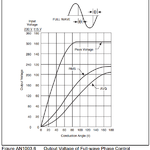bagusdj
Member level 3

- Joined
- Nov 25, 2012
- Messages
- 67
- Helped
- 0
- Reputation
- 0
- Reaction score
- 0
- Trophy points
- 1,286
- Activity points
- 1,766
hey guys, i done my small project. it is controller of ac fan using triac. i referred to this **broken link removed**
however, there are things that confuse me. so i done it by delaying tyristor firing at 3ms ( i got 188V), 4ms ( i got 154V), and 5ms (108.6V). i look for phase firing angle calculation in internet, and at 90 degree of delay angle, it is 155V. main is 220V and 50Hz. 5ms=90 degree.
someone said that the result that i got (188,154,108) is in average voltage. not rms. i use dvm to measures it. not sure it is specified for average or not.
then in pdf it says:

i dont get it, how load can give average value when being measured? knowing that source is rms.
by my data collection, mine is more to average value. is appears in this graph:

average graph tells that at 90 degree, load receives half max rms voltage (in this graph, main is 230V)
while rms graph is not showing half max voltage at 90 degree.
i dont get it, why my data collection is more to average value? i sourced it by 220Vrms main.
and also anybody know the equation of the graph?
please help me
however, there are things that confuse me. so i done it by delaying tyristor firing at 3ms ( i got 188V), 4ms ( i got 154V), and 5ms (108.6V). i look for phase firing angle calculation in internet, and at 90 degree of delay angle, it is 155V. main is 220V and 50Hz. 5ms=90 degree.
someone said that the result that i got (188,154,108) is in average voltage. not rms. i use dvm to measures it. not sure it is specified for average or not.
then in pdf it says:
i dont get it, how load can give average value when being measured? knowing that source is rms.
by my data collection, mine is more to average value. is appears in this graph:

average graph tells that at 90 degree, load receives half max rms voltage (in this graph, main is 230V)
while rms graph is not showing half max voltage at 90 degree.
i dont get it, why my data collection is more to average value? i sourced it by 220Vrms main.
and also anybody know the equation of the graph?
please help me

